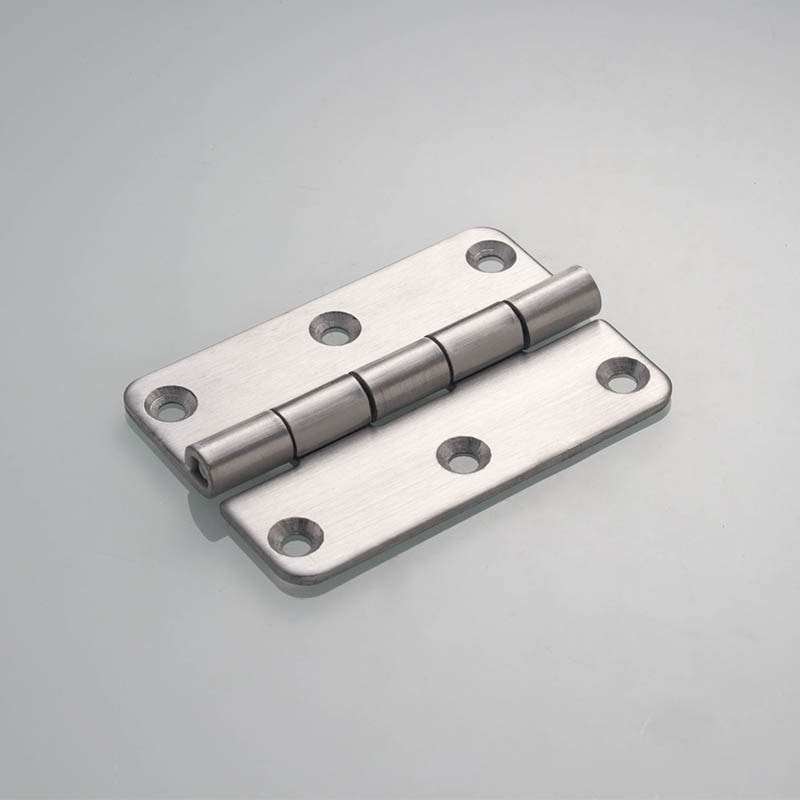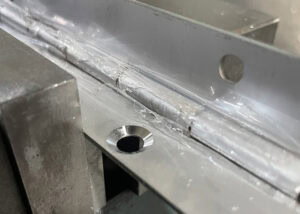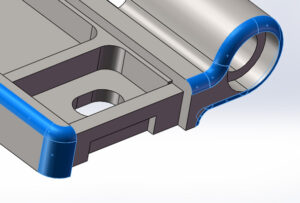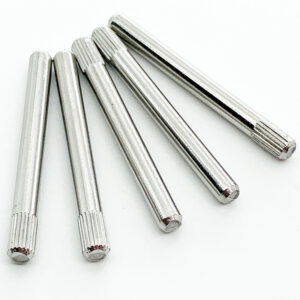In our homes, offices, and various spaces we occupy, the functionality and aesthetics of doors and cabinets largely depend on a small, often overlooked component: the hinge. Among the myriad types of hinges available, flush hinges stand out for their design and application.
Flush hinges are a type of hinge designed to sit flush against the surface of the door and frame, providing a seamless look when the door is closed. They are distinguished by their two leaves: one that attaches to the door and the other to the frame, without the need for a recess to be cut.
This introductory discussion aims to shed light on flush hinges, exploring their mechanics, installation process, advantages, and suitability for various applications, ensuring readers leave with a comprehensive understanding of flush hinges and their unique benefits.

What are Flush Hinges and How Do They Work?
Flush hinges are ingeniously designed to minimize space and provide a clean look for your door installations. Unlike more traditional hinges, such as butt hinges, which require a portion to be recessed into the door and frame, flush hinges are crafted to lie flat, allowing the door to sit perfectly flush with the frame. This is achieved through a unique pivoting mechanism where one leaf fits into the other when the hinge is opened, reducing the gap between the door and frame.
The working principle of flush hinges is straightforward yet effective. When installed, the two leaves of the hinge—the part attached to the door and the part attached to the frame—come together in a compact form. This configuration not only saves space but also simplifies the installation process, as it eliminates the need for chiseling out a recess in the door or frame. The design of flush hinges makes them an ideal choice for lightweight to medium-weight doors, where the emphasis is on aesthetics and efficient use of space.
How Do You Install Flush Hinges on a Door or Cabinet?
Installing flush hinges is a relatively straightforward process, suitable for both seasoned DIY enthusiasts and novices alike. The first step involves accurately marking the positions of the hinges on both the door and the frame or cabinet. Precision is key here, as the alignment affects the door’s operation.
Once the positions are marked, screws are used to attach the hinges to the door and frame. The simplicity of this process is one of the biggest advantages of flush hinges, requiring fewer tools and less time compared to more complex hinge types.
The installation process not only emphasizes the ease of attaching these hinges but also highlights their design efficiency. Unlike other hinges that require cutting into the material for a proper fit, flush hinges are designed for quick and easy mounting on the surface, making them particularly appealing for projects with tight timelines or for those seeking to minimize labor and potential damage to materials.
What are the Advantages of Using Flush Hinges Over Other Types of Hinges?
The advantages of using flush hinges are numerous, with aesthetics and space-saving design leading the charge. Their ability to lie flat against the door and frame ensures a clean, unobtrusive look, enhancing the overall appearance of the door or cabinet. This feature is particularly beneficial in modern and minimalist designs, where every detail counts toward the final aesthetic.
Moreover, the installation efficiency of flush hinges cannot be overstated. Their design eliminates the need for extensive preparation work on the door and frame, saving both time and resources. This aspect, coupled with their compact size, makes flush hinges an excellent choice for a variety of applications, from home furniture to office cabinets, where space is at a premium and a sleek look is desired.
How Do You Choose the Right Size and Type of Flush Hinge for Your Project?
Choosing the right size and type of flush hinge is crucial for ensuring the durability and functionality of your door or cabinet. The weight of the door, the material it is made from, and the frequency of use are key factors to consider. For lightweight doors, a standard flush hinge is typically sufficient. However, for heavier doors or those subject to high usage, opting for a heavier-duty version or a flush hinge with a bearing might be necessary to ensure longevity and smooth operation.
The material and finish of the hinge are also important considerations, especially for projects where aesthetics are a priority. Flush hinges are available in a variety of finishes, allowing for easy matching with door hardware and room decor. Ensuring the hinge material is compatible with the door material is essential to prevent corrosion and wear over time.
Can Flush Hinges be Used for Heavy Doors or Only for Lightweight Applications?
While flush hinges are generally favored for lightweight to medium-weight doors, advancements in hinge design and materials have expanded their application range. For heavier doors, specialized flush hinges designed to handle increased weight without compromising on the sleek, flush appearance are available. These hinges may incorporate bearings and stronger metals, enhancing their load-bearing capacity and durability.
It is important to note, however, that the suitability of flush hinges for heavy doors also depends on the specific application and frequency of use. In cases of extremely heavy doors or high-traffic areas, consulting with a hardware specialist to ensure flush hinges is a relatively straightforward process that DIY enthusiasts can accomplish with some basic tools.
First, you need to mark the position of the hinges on both the door and the frame, ensuring they are aligned correctly to allow smooth opening and closing. Unlike traditional hinges, flush hinges do not require you to carve out a mortise in the door or frame, making installation quicker and less invasive.
To secure a flush hinge, screws are used to attach each leaf to the respective surfaces of the door and frame. It is crucial to ensure that the screws are of the appropriate length and that they are tightened securely, but not so tight that they strip the wood or prevent the hinge from operating smoothly. Proper alignment is key to ensuring that the door or cabinet opens and closes correctly without binding or leaving gaps.
What are the Advantages of Using Flush Hinges Over Other Types of Hinges?
Flush hinges offer several advantages over their counterparts, making them a preferred choice for specific applications. One of the primary benefits is their aesthetic appeal; since they sit flush with the door and frame, they provide a cleaner, more streamlined look. This is particularly desirable in modern or minimalist designs, where visible hardware might detract from the overall appearance.
Additionally, the simplicity of installation is a significant advantage. Since flush hinges do not require the creation of a mortise, they are easier and quicker to install, which can be a boon for DIY projects or in situations where time is of the essence. This ease of installation also means less potential damage to the door and frame, preserving their integrity and appearance.
How Do You Choose the Right Size and Type of Flush Hinge for Your Project?
Selecting the correct size and type of flush hinge is crucial for the functionality and longevity of your door or cabinet. The weight of the door, the material it is made from, and the frequency of use are all factors that should influence your choice. For lightweight applications, such as a small cabinet door, a standard flush hinge made from brass or steel may suffice. However, for heavier doors or those subjected to high usage, a more robust hinge, possibly with bearings, might be necessary to ensure durability and smooth operation.
The width and length of the hinge also play a role in its suitability for a particular project. A larger door will require a hinge that is proportionally larger to distribute the weight evenly and prevent sagging. It’s also essential to consider the finish of the hinge, as this should complement the door and the room’s overall aesthetics.
Can Flush Hinges be Used for Heavy Doors or Only for Lightweight Applications?
Flush hinges are generally more suited to lightweight and medium-weight doors due to their design. The fact that they do not have to be recessed into the door or frame limits their load-bearing capacity compared to more traditional hinges, such as butt hinges, which are cut into the material to provide more support. However, advancements in materials and design have expanded the range of flush hinges to include options that can accommodate heavier doors, though with limitations.
For heavy doors, it is recommended to use a heavier-duty hinge or to increase the number of hinges per door to distribute the weight more evenly. This can help mitigate the limitations of flush hinges in heavier applications, ensuring the door functions correctly and safely.
How Do You Maintain and Adjust Flush Hinges for Smooth Operation Over Time?
Maintaining flush hinges is relatively simple but essential for ensuring their longevity and smooth operation. Regularly checking the screws for tightness can prevent the hinge from loosening, which might cause the door to sag or misalign. Lubricating the hinge with a suitable lubricant can also help maintain smooth operation and prevent squeaking. If the door becomes misaligned or starts to stick, adjusting the position of the hinges slightly can often rectify these issues without the need for complete reinstallation.
Periodic inspections for signs of wear and tear, such as rust or degradation of the hinge material, can help identify when a hinge may need replacing. This preventative maintenance ensures the continued proper function of your doors and cabinets, extending their usable life.
How to Customize a Flush Hinge?
Customizing flush hinges can involve selecting a finish that matches or complements the door hardware and the room’s decor. Many flush hinges are available in a variety of finishes, such as polished brass, chrome, or matte black, allowing for aesthetic customization. Additionally, for specific applications or to achieve a unique look, it may be possible to have flush hinges custom-made or modified by a specialist, though this can significantly increase the cost.
When customizing flush hinges, it’s important to balance aesthetic considerations with functional requirements. Ensuring the hinge is suitable for the door’s weight and usage level is paramount, even when seeking a specific look or finish.
Conclusion
Flush hinges offer a unique combination of aesthetic appeal and practicality, making them a popular choice for many applications. Understanding how they work, how to install them, and how to choose the right type for your needs can help ensure that your doors and cabinets function smoothly and look great.
You may be interested:
- What is a Knuckle Hinge?
- How to Adjust Walk-In Cooler Door Hinges?
- What Are the Characteristics of Industrial CE Marked Hinges?
- Can You Cut Piano Hinges?




